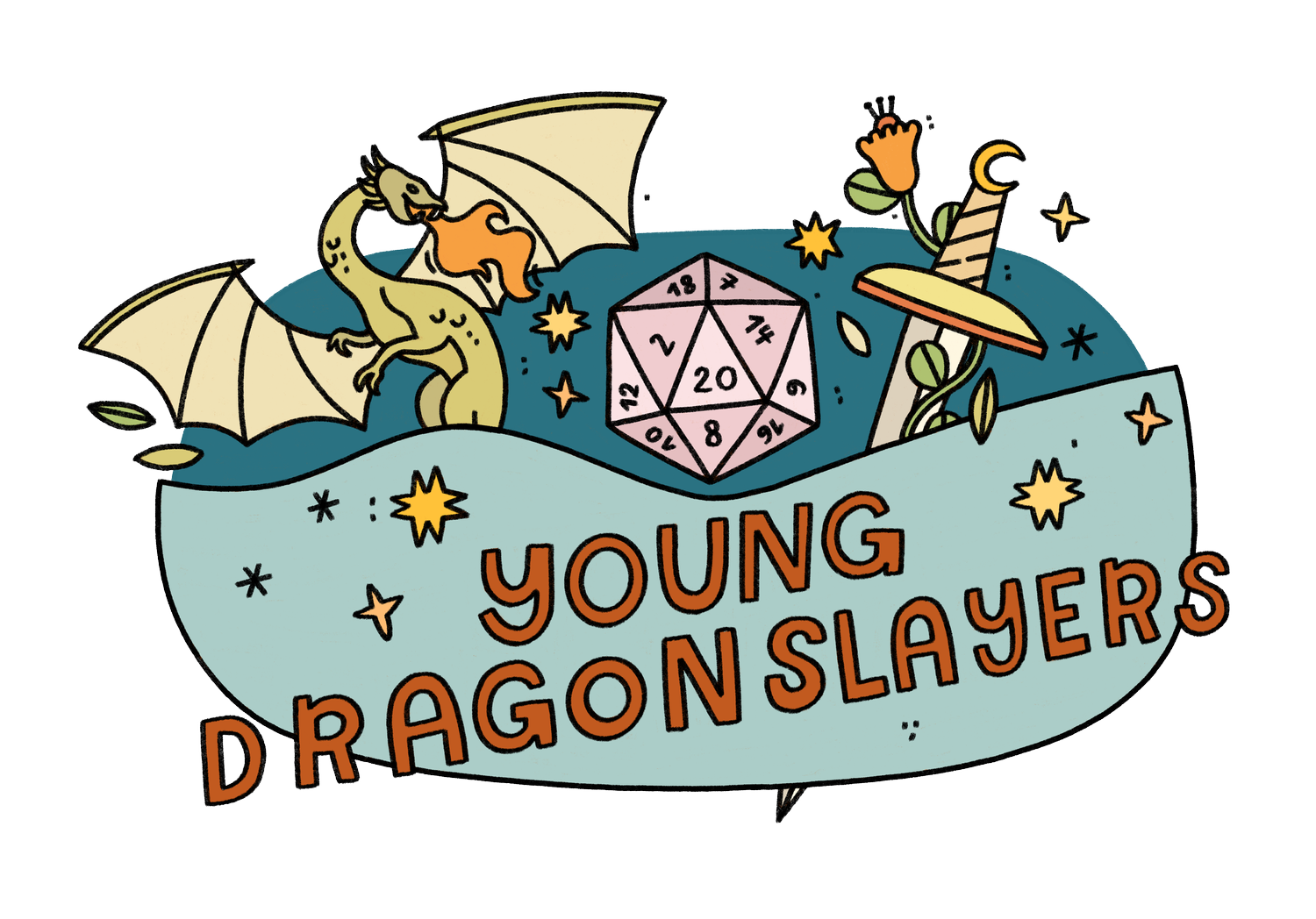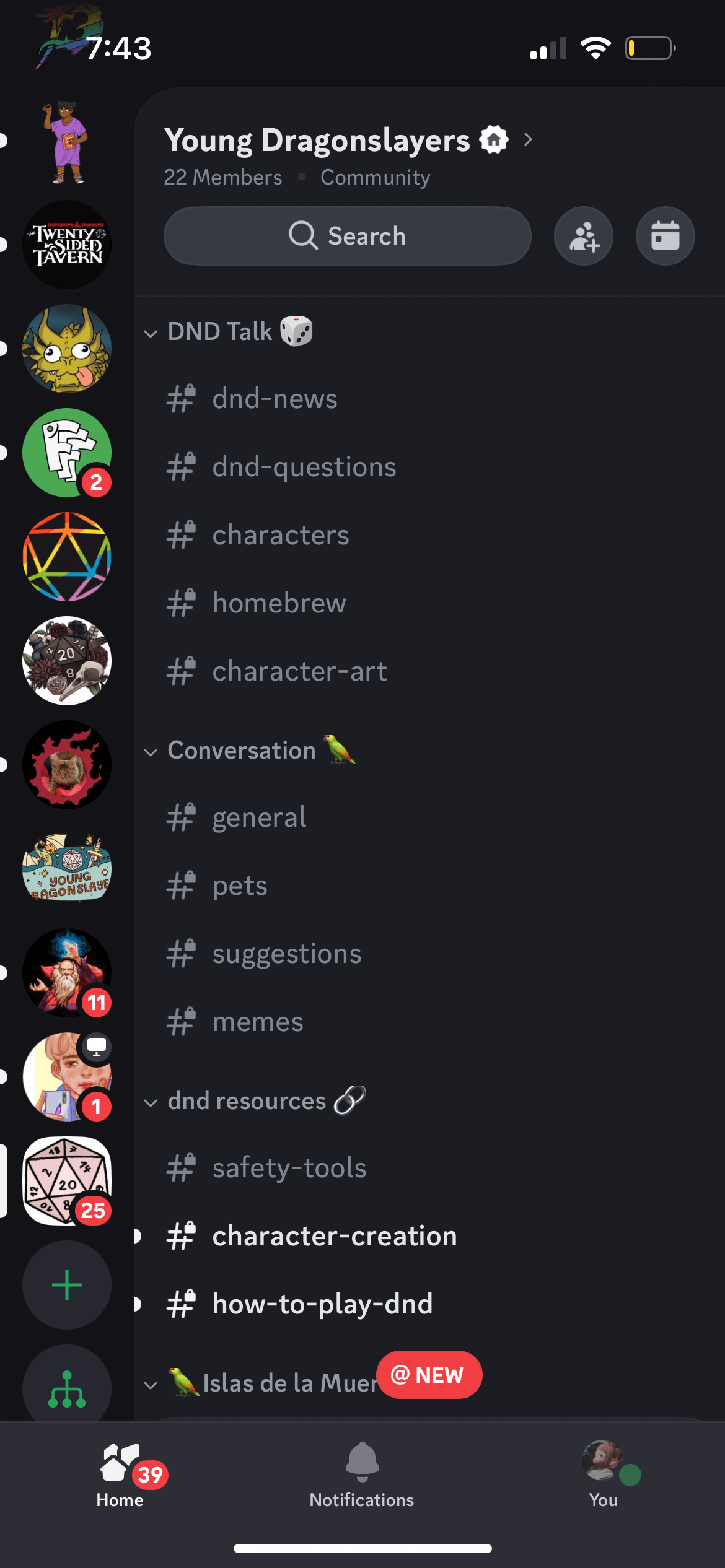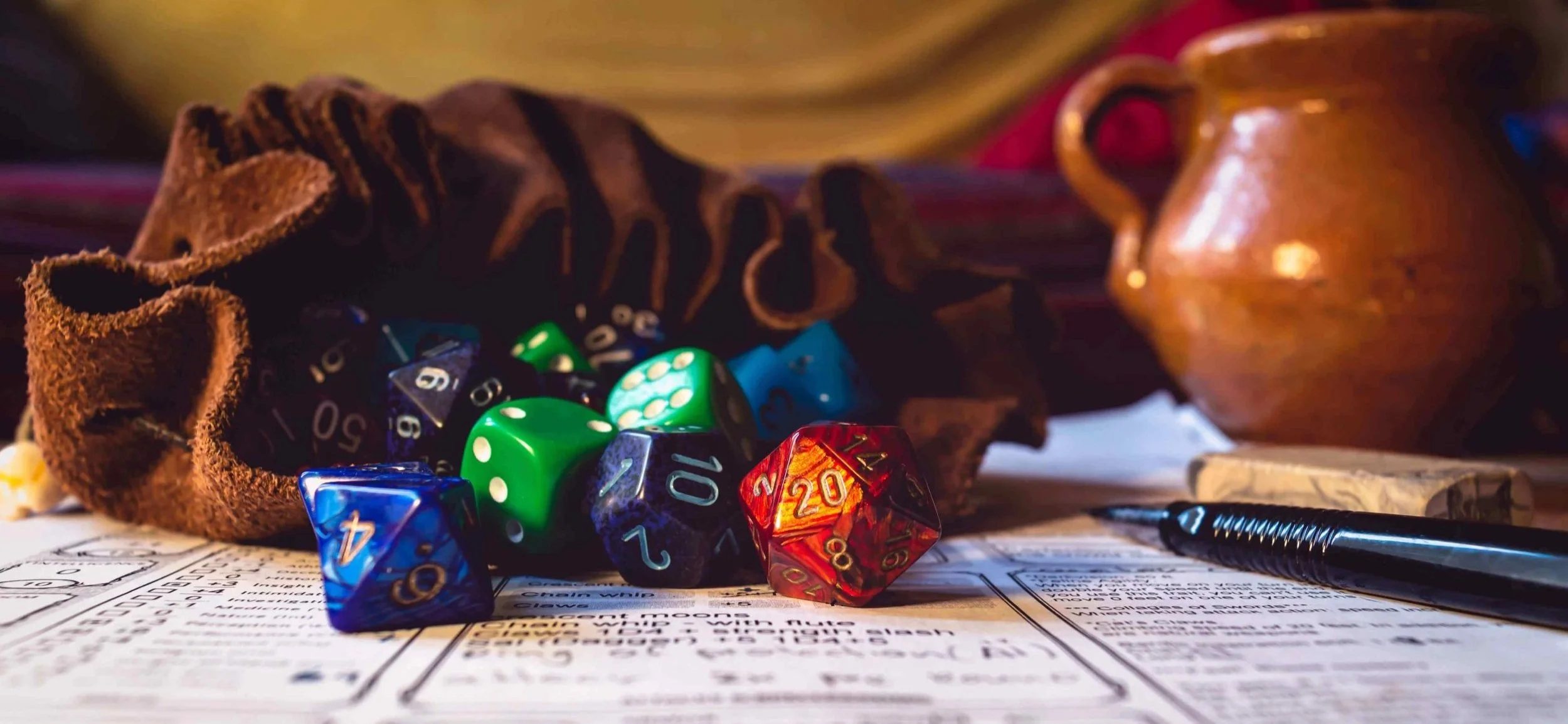Discover Exciting D&D Online Campaigns for All Skill Levels
Looking to take your interest in D&D to a virtual tabletop? You’re not alone. In-person games are great, but it’s often a struggle to get people to commit to showing up week after week to complete a campaign.
If you’re tired of watching your party dissolve, or simply want to escape your role as Forever DM, we can help. We know a thing or two about D&D online campaigns at Young Dragonslayers. Keep reading to learn more.
How Do Online D&D Campaigns Work?
Many online tools exist to help D&D online campaigns feel like in-person ones. You’ll still have a Dungeon Master setting the scene for a group of players navigating a fantasy realm using a mix of rules, character sheets, and a roll of the dice. The only difference is that everything you need—miniatures, maps, character sheets, even dice—has a virtual version.
To start, you’ll need a way to communicate with your fellow players, since you won’t all be in the same room. Zoom and Discord are both great for this (check out our Guide to Discord here.) If you’re looking for more gaming options, Roll20 is a popular virtual tabletop designed for playing D&D. It allows you to chat with friends and manage your character sheet while everyone moves tokens to represent their characters around a shared map.
Everything you’d normally find in a D&D book is also available online. Rather than flipping through the Player’s Handbook or Dungeon Master’s Guide, your party can use sites like D&D Beyond or the DND 5E Wiki to look up monster stat blocks, research spells, or double-check a rule during game play. If you’re not using Roll20, D&D Beyond also has the best online character sheet around. It’s beginner-friendly if you’ve never created a character before, and free to use.
That’s all you really need to play. But if you want to go beyond the basics, you have nearly infinite options for getting fancier with your game. You can use Inkarnate to create your own maps, or browse the millions of maps and tokens created by other players on Pinterest. If you love combat and want visuals to accompany your epic battle, Owlbear Rodeo will be your friend. Hero Forge allows you to create customized, 3-D character art you can use in place of a traditional miniature for online play. For more inspiration, check out our full list of favorite free online D&D resources.
How to Join an Online Campaign
There’s never been a better time to find like-minded players interested in running an D&D online campaign. With so many tools available to make online play fun, many people are moving games online. It makes it easier to find players, since you don’t have to be within driving distance, and it’s often easier to manage everyone’s schedules, too. There are tons of places to look if you’d like to find an online game, including:
Young Dragonslayers (that’s us!) specializes in running online campaigns for kids and teens featuring professional DMs.
Roll20’s Looking for Group tool, which includes both free games and games that charge a fee to join. You can search for open games and sort them based on keywords, when and how often they meet, and whether or not they’re beginner-friendly.
Websites like StartPlaying connect interested players with professional DMs running online campaigns at various price points.
Your Friendly Local Game Store can be a good resource for free games, both in-person and online.
Facebook, Reddit, and Discord all have D&D communities where you’ll likely find someone trying to start up a game.
Attending a convention is a great way to meet new friends interested in running online campaigns.
It may take some trial and error to find a DM whose style you enjoy and fellow players with whom you get along. If at first you don’t succeed, make a graceful exit and try, try again.
While some online game sites include options for ages 13+, many are geared toward adults. Things are a bit more complicated for the under-18 gamer looking for an online campaign. You (or your parent) may not feel thrilled by the idea of joining a group of random internet strangers of various ages for an afternoon of D&D. Fortunately, we know a lot about how to make online campaigns both safe and fun for younger players!
D&D Online Campaigns for Kids
Many online games are designed for adult players, with little moderation or attention to age-appropriate content. No matter how advanced you are as a player, you might encounter scenarios or subject matter in these games that doesn’t feel comfortable. Younger players may also have tighter constraints on their time: a game that starts at 9pm on a weeknight or plays for 5 hours on a Saturday is unlikely to work with a teenager’s extracurricular schedule or attention span.
We’ve also heard younger players say it can be nerve-wracking to meet new peers. Typically, unless you are assembling a group of your own friends, joining a D&D online campaign means playing with strangers. Pair this with the awkwardness of learning a completely new game, and beginning players might feel a bit hesitant to show up at all.
At Young Dragonslayers, we’ve designed our campaigns to remove as many of these barriers as possible. We get to know each player before placing them in a group, taking into account age, interests, experience level, and schedule. This thoughtful matching process helps ensure that players feel like they belong from the very first session. Our meetings are 90 minutes long, which is enough time to make progress on a campaign while still saving time for homework.
Our Game Masters are not only trained in running fun and balanced campaigns—they’re also skilled at supporting kids and teens through those first few awkward moments of joining a new group. We provide a clear structure, facilitate introductions, and create a respectful play environment where every player has a voice.
The result? A group that feels more like a party in every sense of the word—where players can relax, take creative risks, and develop real friendships while adventuring together.
Staying Safe While Playing Online
As exciting as D&D online campaigns can be, anything that takes place on the internet comes with some level of risk—especially when minors are involved. It’s important to keep safety in mind when joining a new online group, whether you’re a player or a parent helping your child get started.
When thinking about online safety in a D&D campaign, it can be helpful to consider three areas of concern:
What happens during the game (such as uncomfortable scenarios or triggering content),
Interactions between players (like disagreements or potential bullying in private messages), and
General online safety risks (including unmoderated chat between sessions or open access to platforms like Discord or Zoom).
Before joining a new D&D online campaign, take a moment to ask:
What personal or identifying information is being shared with the group?
Who’s responsible for moderating the game and setting the tone?
Are there clear rules about content, such as violence, language, or adult themes?
Is there a way to speak up if something in the game makes a player uncomfortable?
Is this an open group anyone can join, or a private, invitation-only session?
If safety is a priority—and it should be—look for groups that start with a Session Zero. This is a planning meeting held before gameplay begins, where the DM and players discuss expectations, build their characters together, and establish ground rules for respectful play. Session Zero also provides a chance to talk about what themes are (and are not) appropriate for the campaign, helping to prevent surprises later on.
Groups that hold a Session Zero often use safety tools, like the X-Card or Lines and Veils, which give players simple ways to set boundaries and handle potentially upsetting content in a low-pressure way. These tools ensure that everyone at the table can stay engaged, safe, and supported while adventuring together..
In addition to what happens during sessions, it’s also important to think about how players interact between games. Many campaigns use platforms like Discord, Zoom, or Roll20 to chat, plan, and stay connected. Players should avoid sharing personal details such as their full name, address, school, or social media accounts. Stick to group chats or moderated channels rather than private messages—especially if you're not already friends with someone outside of the game.
All these platforms have the option to direct message other users, meaning that the DM or other moderators can’t see what you’re saying. However, there are ways to make platforms safer by altering the settings (check out our Parent’s Guide to Discord for more ideas.)
Discord allows users to disable direct messages from non-friends and limit who can send friend requests or join servers.
Zoom supports password-protected meetings, waiting rooms, and host-only screen sharing to prevent unwanted disruptions.
Roll20 offers invite-only games and DM permissions to restrict what players can see or do on the virtual tabletop.
At Young Dragonslayers, all our games are moderated by background checked DMs, and we utilize both Session Zeroes and safety tools in our games. We also screen all interested players in advance and do our best to match them with peers who are close in age and maturity level.
Need Inspiration? Try These Campaign Ideas
When you think of D&D, you probably imagine a traditional high fantasy setting: orcs, elves, castles… the usual Lord of the Rings-type stuff. But D&D adventures can take place just about anywhere. If you’re preparing to launch your next online campaign, maybe it’s time to venture beyond medieval times and try something a little more unexpected.
Virtually any D&D campaign translates well to online play, so most premade modules—official or third-party—are fair game. If you prefer homebrew, the vast array of free online tools for Dungeon Masters makes it easier than ever to create your own content (or reskin someone else’s creation).
At Young Dragonslayers, our campaigns span a variety of settings and genres, running the gamut from fantasy to sci-fi, post-apocalyptic to anime, pirates to cowboys, and everything in between. If you’re looking for inspiration to kick things off, check out these suggestions from our veteran Dungeon Masters.
-
Fantasy settings tend to be pretty landlocked, with battles occurring in forts, castles, mysterious forests or open fields. But why limit yourself to solid ground when you could be pitting battleships against each other on the open sea? Setting your campaign in a seafaring world opens you up to all kinds of fresh possibilities. It’s a chance to explore lesser-used species, like Merfolk, aquatic elves, and Locathah, a humanoid fish race perfect for exploring the depths.
There are plenty fun aquatic monsters to choose from. Consider throwing in a sea hag, a shape shifting menace who can drop a player to 0 HP with a single glare. Or a Marid, a plump water genie known for long-winded tales and a short temper toward anyone who interrupts. Storm giants and Sahuagin—also known as “sea devils”—are other great adversaries for watery campaigns.
Our Dungeon Master, Jaclyn, recommend adding a port city to your map to give players a place to rest, refuel, and potentially gather intel. Consider adding some spice—and extra game mechanics—by setting combat aboard your ship or even underwater, where many characters will be disadvantaged. Finally, you can’t go wrong with buried treasure as a tried-and-true plot hook. Check out her full blog post on running a nautical-themed campaign for more ideas.
-
Studio Ghibli is known for producing beautifully animated films like Spirited Away, My Neighbor Totoro, and Kiki’s Delivery Service. Director Hayao Miyazaki’s aesthetic is instantly recognizable—peaceful, magical, and infused with folklore and fairytale elements. If I were a D&D character, these are the kinds of worlds I’d want to wander through.
To evoke a Studio Ghibli feel in your campaign, our Dungeon Master Sergio recommends building a richly detailed world where conflict is minimal and player goals are more personal or small-scale. While Miyazaki is a Japanese director, his films take place in a wide variety of settings, so you don’t need to limit yourself to a single culture or time period. Ghibli stories also tend to focus on young protagonists and coming-of-age arcs, so keep this in mind when creating characters and party dynamics.
Of course, no adventure is complete without conflict—but in Ghibli-inspired tales, tension usually stems from natural disasters, war, or misunderstandings rather than a classic villain. If you do include a monster, consider making them a complex or misunderstood figure, rather than a purely evil final boss. Read our full blog post on running a Ghibli-style D&D campaign for more tips on building this type of world.
-
If your group is full of Star Wars fans, why not build a campaign that channels the feel of a galaxy far, far away? With a little creativity, it’s easy to create D&D characters that feel like Force users. Our blog post on Star Wars-inspired D&D characters walks you through how to do it using existing classes and subclasses.
For example, a Monk with the Way of the Kensei subclass can feel a lot like a lightsaber-wielding Jedi if you select the Sun Blade as their dedicated weapon. A Sorcerer is a great option for any “chosen one” character, like Anakin or Grogu, who was born with innate Force abilities like healing, moving large objects, or mind control. If you select the Aberrant Mind subclass, you can even form telepathic bonds and teleport like Rey and Kylo. Warlocks can also let you explore the padawan/Jedi master dynamic, especially if your character crosses over to the Dark Side.
Aside from the Sun Blade being an excellent stand-in for a lightsaber, you can reflavor other standard weapons and armor to feel more futuristic—think blasters, vibroblades and personal shield generators instead of crossbows, daggers, and chainmail. Whether you set your story in deep space or on a desert planet at the edge of civilization, there’s no shortage of ways to reskin existing content to fit a sci-fi theme.
-
Given the ample D&D references that already exist in the world of Gravity Falls, it’s a natural fit as a campaign setting. Our Dungeon Master and blogger, Hannah, has been working on her own Gravity Falls-inspired one shot for some time. She shares some tips for how to adapt Gravity Falls characters into D&D PCs or NPCs in her blog post on Gravity Falls homebrew.
Hannah believes Mabel Pines is a quintessential College of Creation bard, and suggests equipping her with spells like Fast Friends, Motivational Speech, and Animal Messenger to reflect her positive energy and love of Waddles. While she considered a Wizard build for Dipper, she ultimately decided an Inquisitive Rogue was a better fit for Dipper’s keen eye and detective abilities. The whole post is worth a read, but let it be known that she proposes reskinning an Owlin Wild Magic Sorcerer if you want to make Bill Cipher a player character.
A campaign based on solving a supernatural mystery is a natural fit for the world of Gravity Falls. Consider filling your story with puzzles, traps, and intriguing clues for your more observant characters to discover. While options abound for supernatural villains, this sort of campaign would be a wonderful fit for a party that preferred investigation and roleplay to combat.
-
Percy Jackson fans and history buffs alike will rejoice at the prospect of an online campaign inspired by ancient myth. As Jaclyn points out in her blog on Irish mythology, many well-known D&D creatures—like Medusa and the Sphinx—are borrowed directly from the myths of real-world cultures. However, you have plenty of more obscure options to choose from if you dig a little deeper into the Monster Manual. Consider adding a banshee (a ghost who impersonates young women), a Duhallan (a headless horseman), or a Fomorian (a murderous giant with an evil eye) as an unexpected foe.
As far as player character options, a Firbolg or Druid would be a natural choice for a Celtic campaign, but I’d also be tempted to play a Changeling. As far as NPC’s, Jaclyn’s suggestion to include Isolde, who was based on a legendary princess, is hard to beat.
Of course, a mythological world is going to need deities, and plenty of the traditional D&D ones are also based on mythical gods and goddesses. D&D 5E offers “Fantasy-Historical Pantheons” based on the Celtic, Norse, and Ancient Greek gods. According to DNDBeyond, these are “fantasy interpretations of historical religions from our world's ancient times” that are “divorced from their historical context in the real world.” Nobody in ancient times was assigning alignments or domains to their gods. For Jaclyn’s top 5 suggestions, check out her blog on the Norse Gods of D&D here.
You’ll get to decide whether your campaign takes place in a historical fiction setting (like Ancient Rome) or in more of a modern-meets-ancient mashup, a la Percy Jackson. Alternatively, you can use the myths themselves as inspiration for a story arc. Perhaps your characters must undergo trials to prove themselves, like Hercules, or go on a rescue mission to the Underworld, like Orpheus. Folks have been successfully adapting these myths for thousands of years, so it’s hard to go wrong.
What Players Say About Our Online Games
Curious about joining an online campaign? If you’re a D&D enthusiast between the ages of 10 and 18 (or the parent of one), we’d love to have you join us at Young Dragonslayers. We’re a fully virtual company of professional DMs who are passionate about introducing young players to the game.
We strive to create high-quality experiences for kids who are serious about D&D (at any experience level) in an environment that is also safe and supportive. Everyone on our team has a professional background working with kids, so we will happily nerd out over the rules while also allowing flexibility for, say, a player who wishes to summon an army of Shreks. And, as a therapist-founded company, we’re also big on inclusivity and welcoming players of all kinds to our (virtual) table.
Here’s what players and their families have to say about us:
Join a D&D Online Campaign with Young Dragonslayers
When you join Young Dragonslayers, we take the time to match you with a group where you’ll truly feel at home. We consider age, experience level, play style, and of course, scheduling—so you’re not just placed randomly, but thoughtfully grouped for the best possible experience. Because of this, our enrollment process is a little different from what you might find with other online programs. Here’s how it works:
Join the waiting list. We open enrollment once per quarter and offer our games in 10-session packages. This lets players experience a full story arc without interruption. Tell us about your player here.
Meet with us. Every family has a 15-minute Zoom call with one of our team members. It’s a chance to ask questions, share preferences, and help us make the best group match possible. It also gives us a chance to make sure our games stay safe, supportive, and fun for everyone.
Start playing! After your meeting, we’ll follow up with an invitation to join a group that fits your schedule, personality, and interests. Complete your registration online—and you’re ready to roll.
We welcome players of all backgrounds, genders, and experience levels, and we strive to be an inclusive, affirming space for every adventurer. While players can join from anywhere, our games work best for kids and teens in U.S. time zones: Eastern, Central, Mountain, and Pacific.
Enough about us—we want to hear about you! Click here or use the button below to get started.





